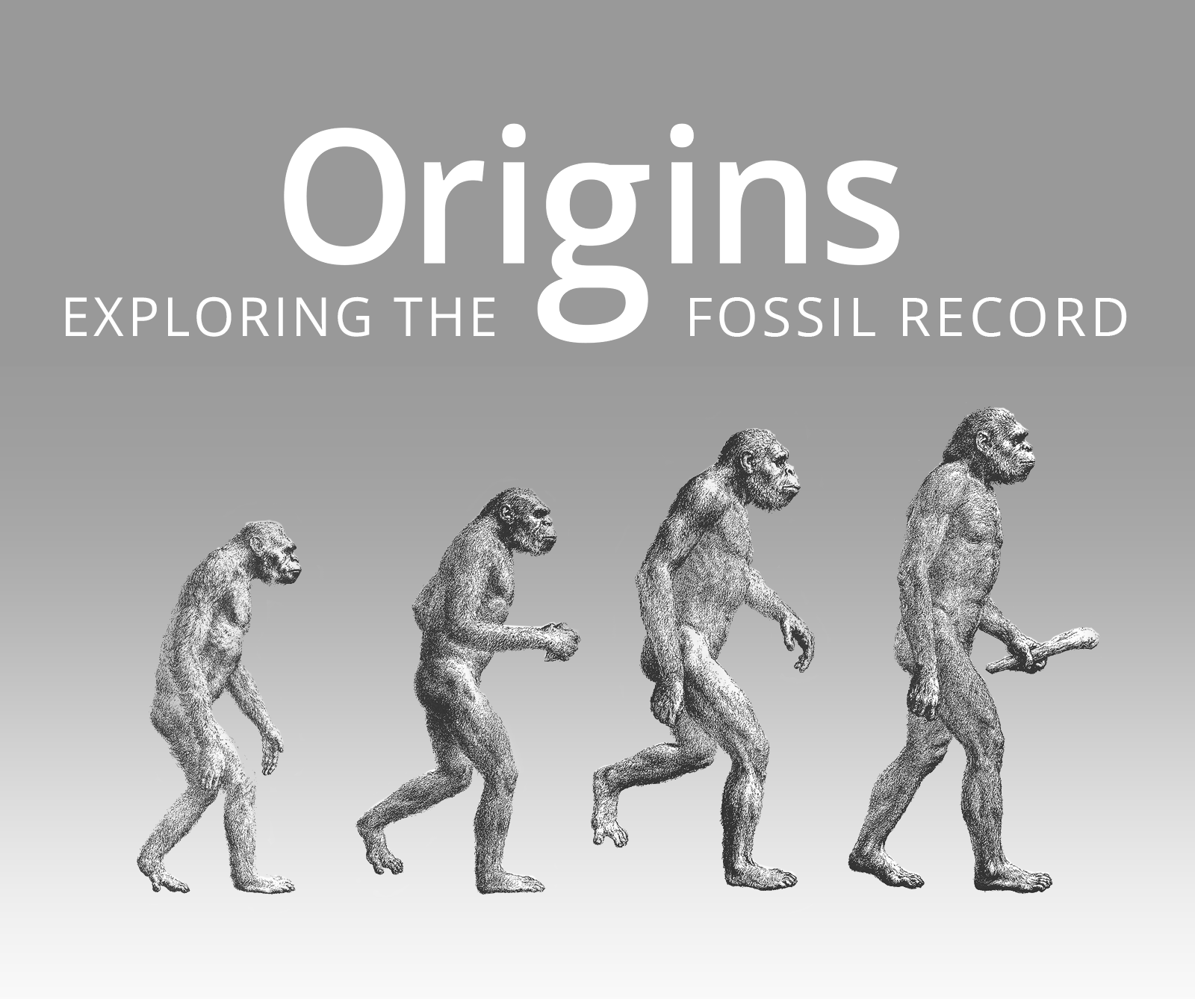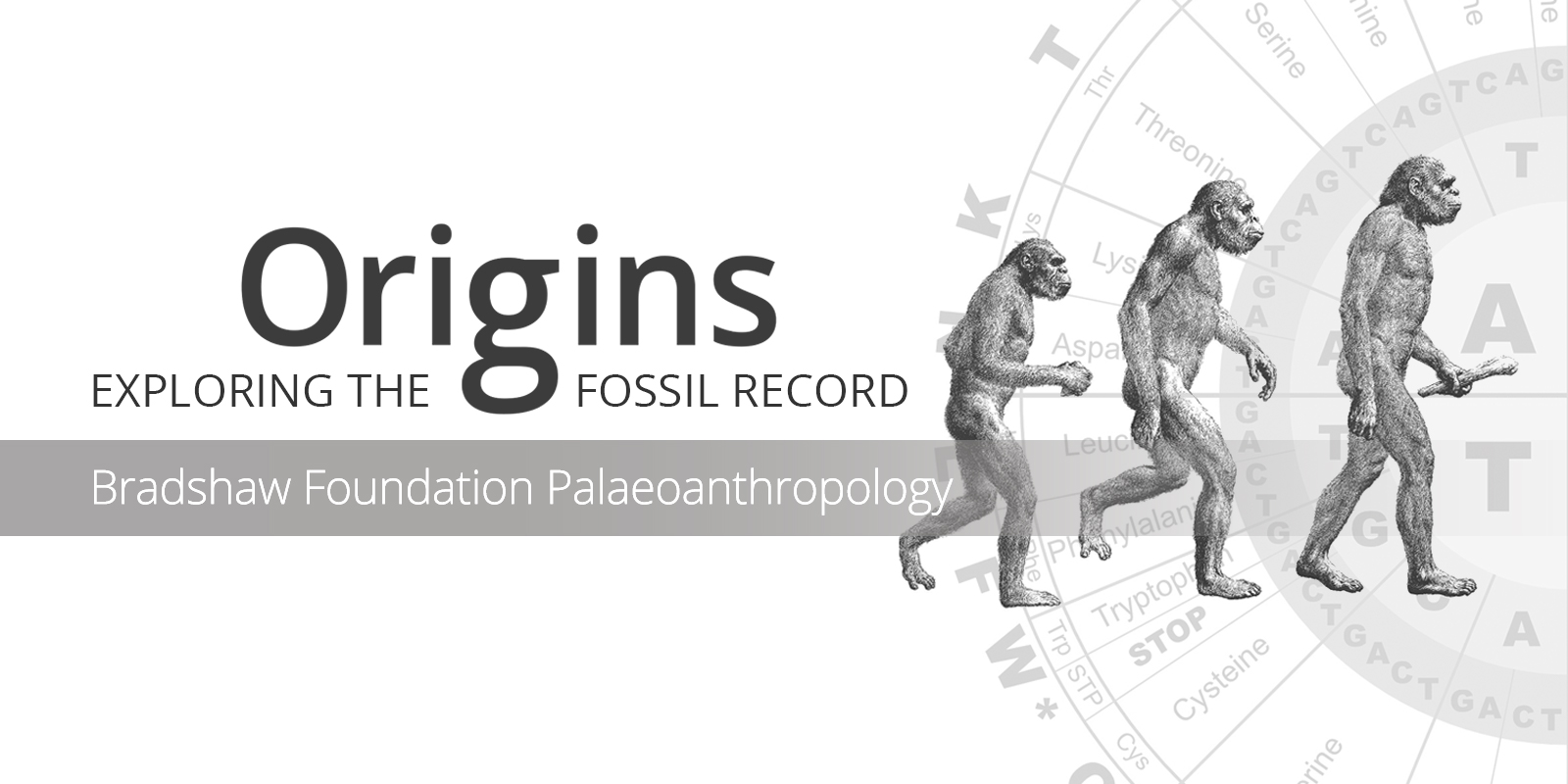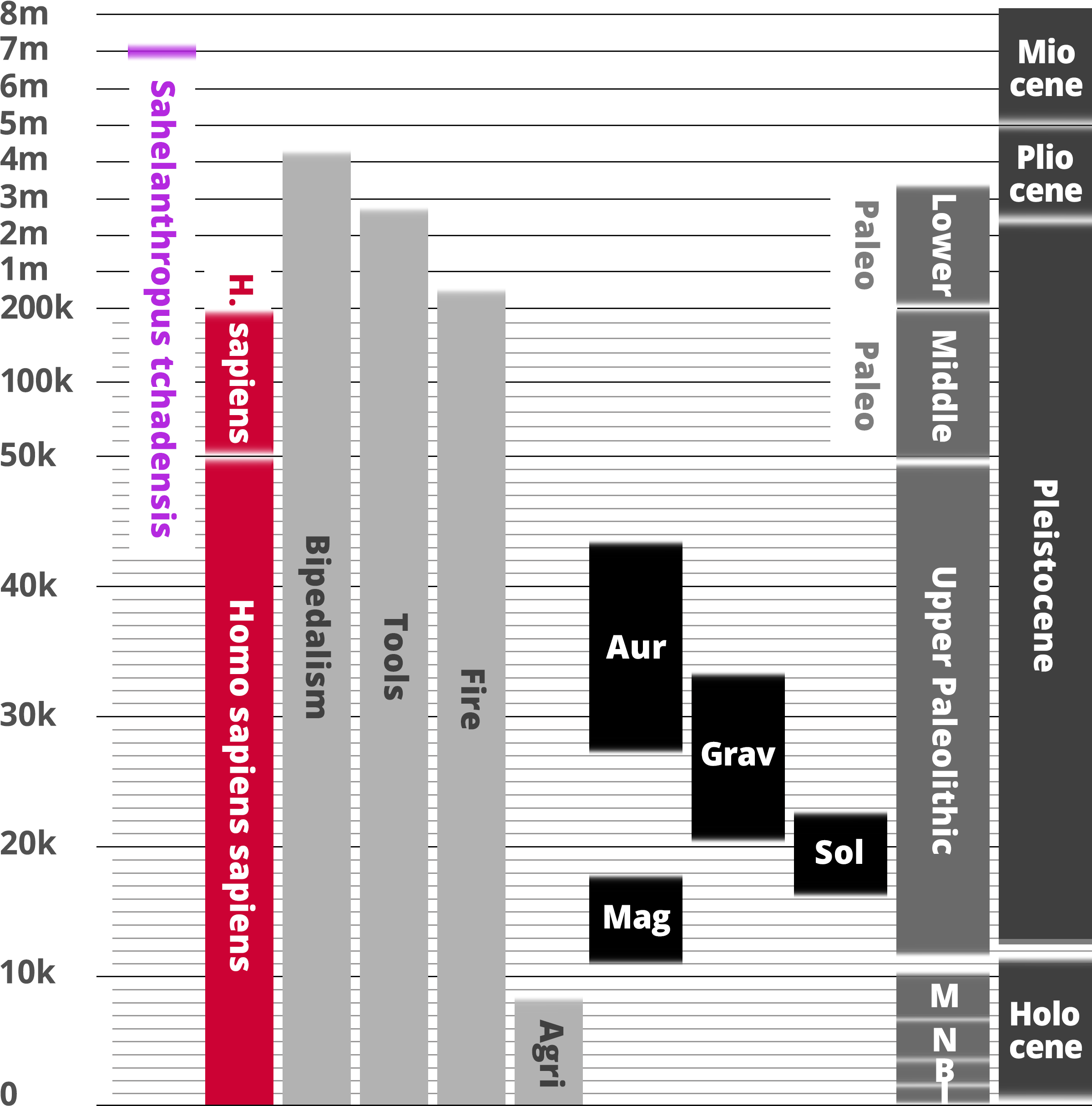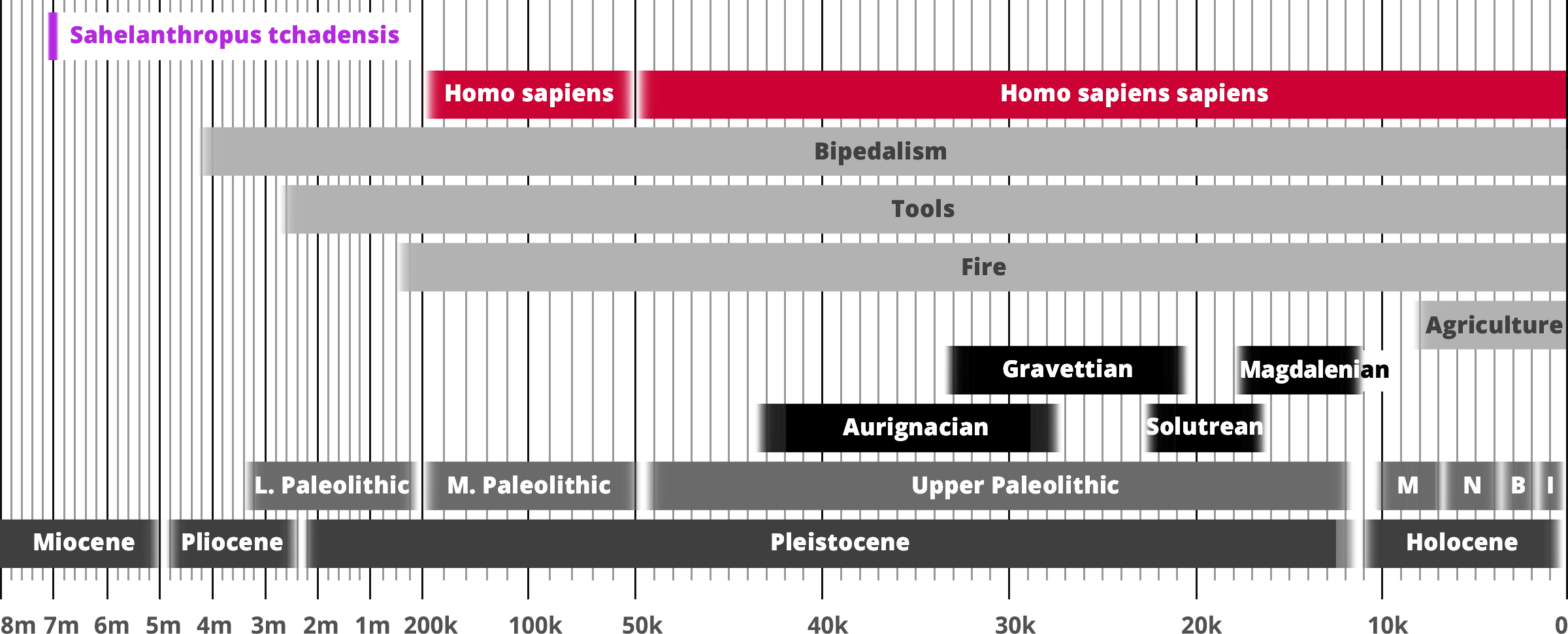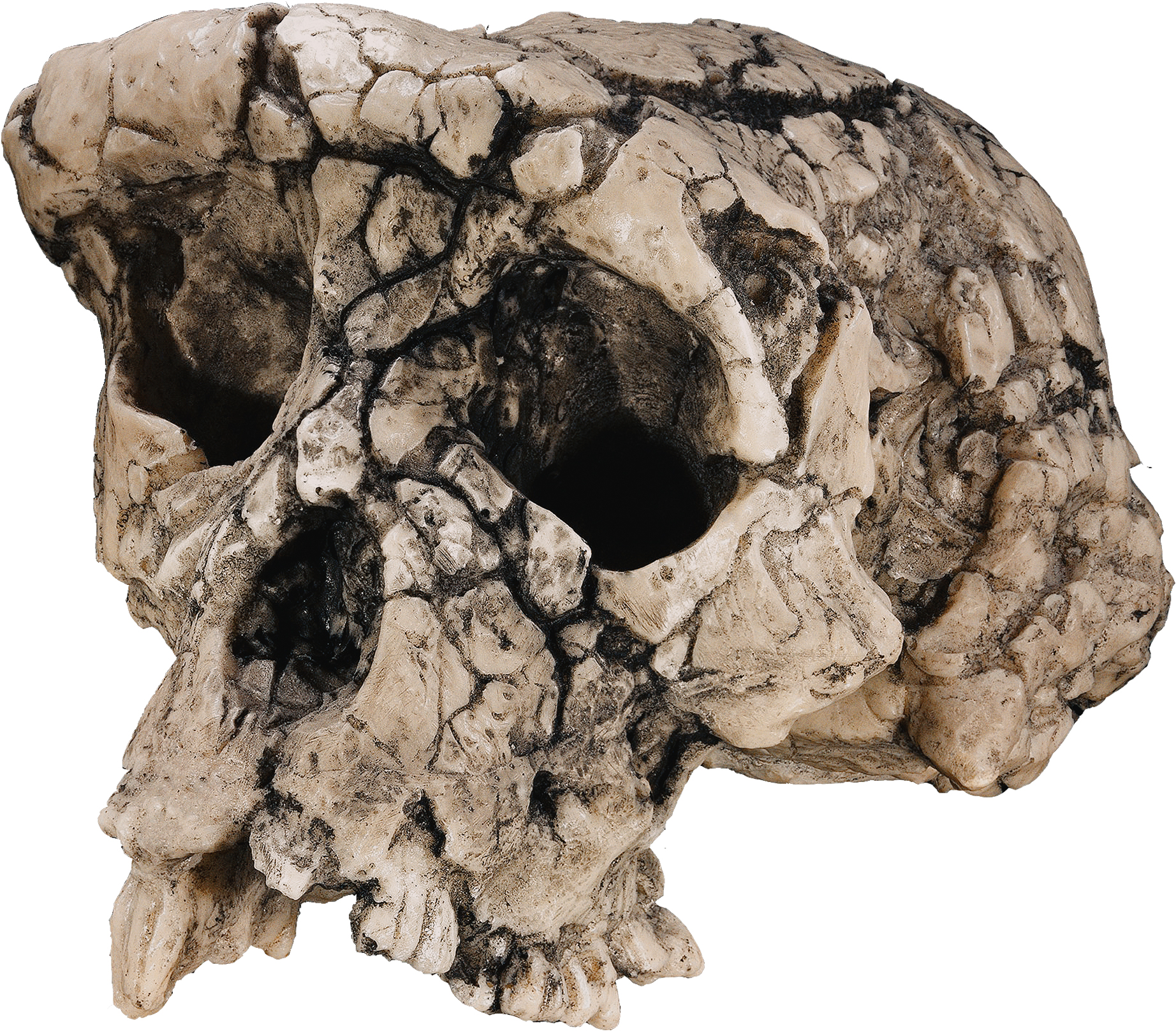Sahelanthropus tchadensis
Homo sapiens
Hominin traits
Archaeological industry/Technocomplex including art
Period in human prehistory: M = Mesolithic; N = Neolithic; B = Bronze Age; I = Iron Age;
Geological epoch
* Note: Table based past and current research and scientific consensus
Sahelanthropus tchadensis
Homo sapiens
Hominin traits
Archaeological industry/Technocomplex including art
Aur = Aurignacian; Mag = Magdalenian;
Grav = Gravettian; Sol = Solutrean
Period in human prehistory:
M = Mesolithic; N = Neolithic;
B = Bronze Age; I = Iron Age;
Geological epoch
* Note: Table based past and current research
and scientific consensus
Sahelanthropus tchadensis
| SAHELANTHROPUS TCHADENSIS |
 |
| Genus: |
Sahelanthropus |
| Species: |
Sahelanthropus tchadensis |
| Other Names: |
Toumaï (Hope of Life) |
| Time Period: |
7 million years ago |
| Characteristics: |
Pre-Human/Chimanzee Divergence |
| Fossil Evidence: |
Skull Cranium, Chad, Africa |
Sahelanthropus tchadensis is an extinct hominid species that is dated to about 7 million years ago. In terms of paleoanthropology and the origins of human evolution, including it in the Hominina evolutionary tree is still controversial, because its classification is older than the human-chimpanzee divergence of 6.3 to 5.4 million years ago, and the specimens are few. The partial cranium, discovered in Chad in 2001 by Michel Brunet and his team, is known as Toumaï, meaning 'hope of life'. [Brunet et al. 2002].
The braincase - 380 cm3 - is similar to that of extant chimpanzees, and the teeth, brow ridges and the flatter facial structure differ greatly to those found in
Homo sapiens. The cranial remains alone cannot indicate if Sahelanthropus tchadensis was bipedal.
Sahelanthropus may represent a common ancestor of humans and chimpanzees. However, if Toumaï is a direct human ancestor, then its facial features bring the status of Australopithecus into doubt because its thickened brow ridges were reported to be similar to those of some later fossil hominids - such as
Homo erectus - whereas this morphology differs from that observed in all australopithecines, most fossil hominids and extant humans.
According to the Smithsonian National Museum of Natural History, Sahelanthropus tchadensis - also known as 'Toumaï' - is one of the oldest known species in the human family tree. This species lived sometime between 7 and 6 million years ago in West-Central Africa - the first early humans, or hominins, diverged from apes sometime between 6 and 7 million years ago in Africa. Walking upright may have helped this species survive in diverse habitats, including forests and grasslands. Although we have only cranial material from Sahelanthropus, studies so far show this species had a combination of ape-like and human-like features. Ape-like features included a small brain (even slightly smaller than a chimpanzee’s), sloping face, very prominent browridges, and elongated skull. Human-like features included small canine teeth, a short middle part of the face, and a spinal cord opening underneath the skull instead of towards the back as seen in non-bipedal apes.
Some of the oldest evidence of a humanlike species moving about in an upright position comes from Sahelanthropus. The foramen magnum (the large opening where the spinal cord exits out of the cranium from the brain) is located further forward (on the underside of the cranium) than in apes or any other primate except humans. This feature indicates that the head of Sahelanthropus was held on an upright body, probably associated with walking on two legs.
Regarding the discovery of this species, the first (and, so far, only) fossils of Sahelanthropus are nine cranial specimens from northern Chad. A research team of scientists led by French paleontologist Michael Brunet uncovered the fossils in 2001, including the type specimen TM 266-01-0606-1. Before 2001, early humans in Africa had only been found in the Great Rift Valley in East Africa and sites in South Africa, so the discovery of Sahelanthropus fossils in West-Central Africa shows that the earliest humans were more widely distributed than previously thought.
Most of Sahelanthropus’ teeth are heavily worn, and there have not yet been studies of its tooth wear or tooth isotopes to indicate diet, but based on its environment, researchers can infer that it ate a mainly plant-based diet. This probably included leaves, fruit, seeds, roots, nuts, and insects.
The skull was nicknamed Toumaï by the then-president of the Republic of Chad, Idriss Déby, not only because it designates in the local Daza language meaning "hope of life", given to infants born just before the dry season and who, therefore, have fairly limited chances of survival (Source: Wikipedia). But for Idriss Déby it was also to celebrate the memory of one of his comrades-in-arms, living in the north of the country where the fossil was discovered, and killed fighting to overthrow President Hissène Habré supported by France. Toumaï also became a source of national pride, and Brunet announced the discovery before the Ministry of Foreign Affairs and a television audience in the capital of N'Djamena, "l'ancêtre de l'humanité est Tchadien...Le berceau de l'humanité se trouve au Tchad. Toumaï est votre ancêtre" ("The ancestor of humanity is Chadian...The cradle of humanity is in Chad. Toumaï is your ancestor.")
There is no complete palaeoanthropological consensus however becuase of the discovery's sequence of events. Toumaï had been found with a femur, but this was stored with animal bones and shipped to the University of Poitiers in 2003, where it was stumbled upon by graduate student Aude Bergeret the next year. She took the bone to the head of the Department of Geosciences, Roberto Macchiarelli, who considered it to be inconsistent with bipedalism contra what Brunet et al. had earlier stated in their description analysing only the distorted skull. This was conspicuous because Brunet and his team had already explicitly stated Toumaï was associated with no limb bones, which could have proven or disproven their conclusions of locomotion. Because Brunet had declined to comment on the subject, Macchiarelli and Bergeret petitioned to present their preliminary findings during an annual conference organised by the Anthropological Society of Paris, which would be held at Poitiers that year. This was rejected as they had not formally published their findings yet. They were able to publish a full description in 2020, and concluded Sahelanthropus was not bipedal.
In 2022, French primatologist Franck Guy and colleagues reported that a hominin left femur (TM 266-01-063), and a right (TM 266-01-358) and a left (TM 266-01-050) ulna (forearm bone) were also discovered at the site in 2001, but were excluded originally from Sahelanthropus because they could not be reliably associated with the skull. They decided to include it because Sahelanthropus is the only hominin known from the site, and they concluded that the material is consistent with obligate bipedalism, the earliest evidence of such. In 2023, Meyer and colleagues suggested that its phylogenetic position and its status as a hominin still remain equivocal.

